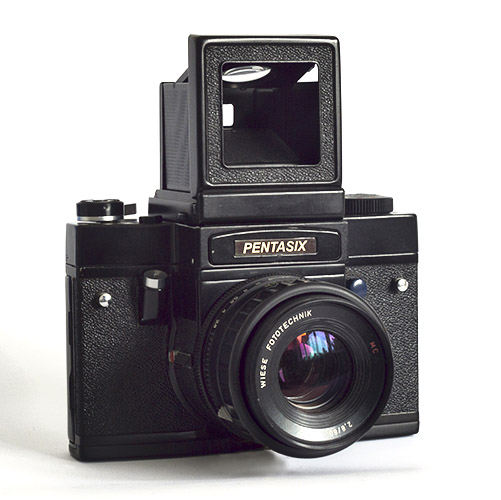
This camera looks familiar - apart from the name!
[wpx60_04.jpg]
The History of the Pentacon Six
Wiese Fototechnik
80mm lens and cameras: the Pentasix

| In the 1990s, a company in Hamburg by
the name of Wiese Fototechnik started advertising various
cameras and lenses that bore the name “Wiese”. All
the items seen so far appear to have been based on
products from the Arsenal factory in Kiev, Ukraine.
These items had purportedly been “improved”, although
whether the improvements took place in Hamburg, or in
Kiev, or perhaps somewhere else, is not clear. For his cameras, Richard Wiese chose the name “Pentasix”. This was a clever name, incorporating the idea of a pentaprism – even though the camera reported on here does not have one! “Six” obviously refers to the nominal format of the film. It also hints at cameras such as the Praktisix, the Pentacon Six, the Kiev 6C and the Kiev 60, and no doubt might have led some potential vendors to think of the prestigious brand “Pentax”. However, “Pentasix” was not so much a model name as a brand name, that was applied both to cameras based on the Kiev 60 (a camera inspired by the Pentacon Six) and to cameras based on the Kiev 88 (a camera inspired by the Hasselblad 1000F). |
| The particular camera that we are
looking at here is clearly based on a Kiev 60 and on the
80mm Volna lens that was supplied with it, as will be
obvious from the image to the right. You can read
more about the Kiev 60 here. Below is a picture of the standard Kiev 60 waist-level finder, another one of which also came as part of the above “Pentasix”. You can read more about this finder here.
|
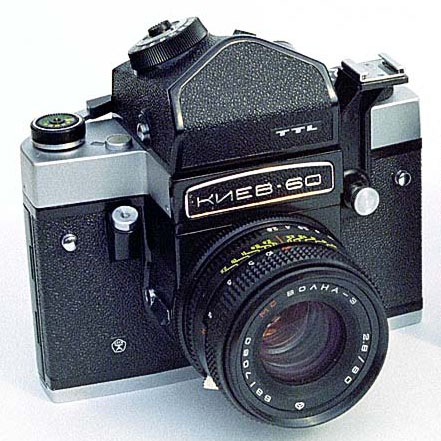 [c149_21k60.jpg]
This Kiev 60 is shown here with its
metering prism attached, and it has its standard flash
bracket screwed to the front of the camera. This
bracket is not supplied with the “Pentasix, and
the hole for it on the body has been covered.
See below.
|
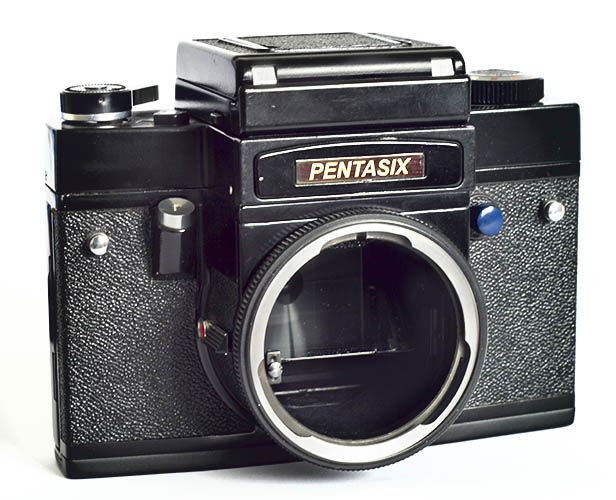 [wpx60_01.jpg] |
In Wiese's “Pentasix”,
the bottom of the camera throat and the back of the mirror
plate are flocked. As can be seen here, flocking of the Kiev
60 camera throat is essential, as otherwise the shiny
surfaces reflect light in multiple directions, degrading
the image. So this upgrade has a definite positive
effect on image quality. As is obvious from this picture, the “Pentasix” has the original Kiev 60 lens mount, which is copied from the original Praktisix/Pentacon Six mount.
|
|
It is on the other side of the throat
of the lens mount and mirror chamber that some
significant differences can be observed on the
“Pentasix”.
First notice the little chrome-coloured button on the front surface of the camera. This is a mirror pre-release, also known as a “mirror lock up” or “MLU”. Releasing the shutter on this Pentasix makes exactly the same, loud noise as on a Kiev 60 (unlike the nearly-silent shutter on the Pentacon Six!). More important, when the rapidly-moving mirror hits the stop point just below the focussing screen, this must cause serious vibrations. While these are nowhere near as bad as on the Pentax 6×7 or the Pentax 67 (see here), on occasions when the camera is used for macro photography or with an extremely long lens, the vibrations can ruin image sharpness. This is why various manufacturers offered cameras with a mirror pre-release or mirror-lock up. This is not a standard feature on the Kiev 60, nor on the Pentacon Six and Exakta 66, although for many years it was offered for the latter two cameras by Pentacon in Germany. See details here and here. At the time of writing (18th January 2016), Baierfoto in Germany still offers a two-stage system that releases the mirror and then the shutter on the Pentacon Six. Baier's website is here. However, perhaps even more interesting is the lever on the camera throat, just to the front of the mirror pre-release button. This resets the mirror. This is a major plus feature. Imagine that you are taking a macro shot of a butterfly. You've metered and set aperture, shutter speed and focus. You pre-release the mirror on your Pentacon Six or Exakta 66 and wait a couple of seconds for any vibrations to die down. Then, just before you fire the shutter, the butterfly flies away! With the Pentacon Six and Exakta 66 there is no way to reset the mirror. The only thing that you can do is complete the process that you have started, and fire the shutter -- even if it ends up being a wasted shot. After all, with the mirror up you can't re-compose or re-focus. However, if you are using this Pentasix and the same thing happens, you can activate the lever and re-set the mirror -- a major plus! |
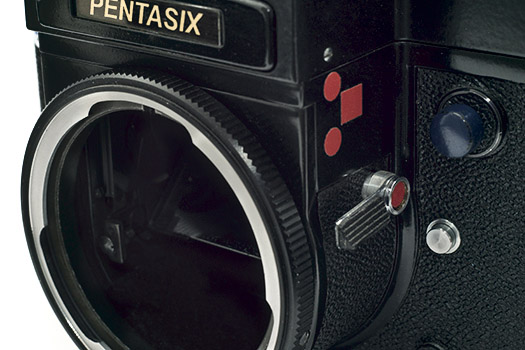 I don't know the meaning of the two large red dots and the red square on the side of the camera throat (if they have a meaning). The camera came without instructions. [wpx60_03.jpg] |
Two views of the back of this Pentasix,
without and with the waist-level finder.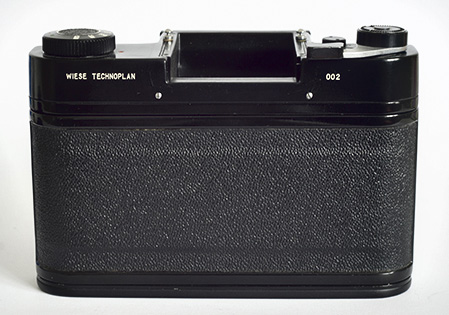 [wpx60_06.jpg] |
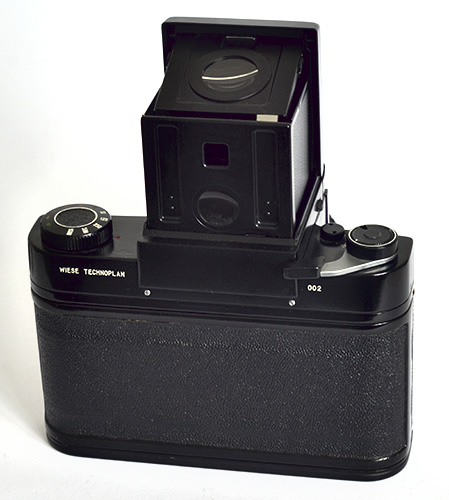 [wpx60_07.jpg] |
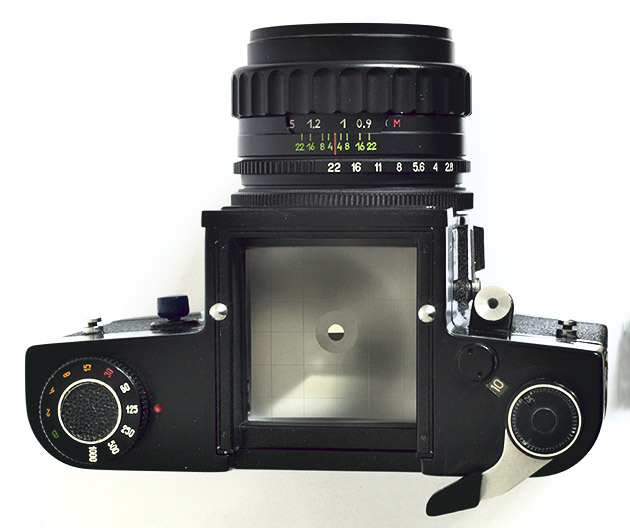 [wpx60_05.jpg] |
This view of the top of the camera shows
the excellent focussing screen with which it is
equipped. This is a bright screen, with rangefinder
focussing wedges in the centre and fine gridlines that can
aid composition and help the user to keep the camera
level. (The variations in brightness on different
parts of the screen merely correspond to the area towards
which the lens was pointing when this picture was taken.) This image also gives a good view of the lens that was supplied with this Pentasix. As indicated above, optically this appears to be the standard 80mm Volna lens. However, it appears to be in a totally new barrel.
|
|
I stated above that “Pentasix”
was not so much a model name as a brand
name. Here are some pictures of a
“Pentasix” from Wiese that is based on a
modified Kiev 88.
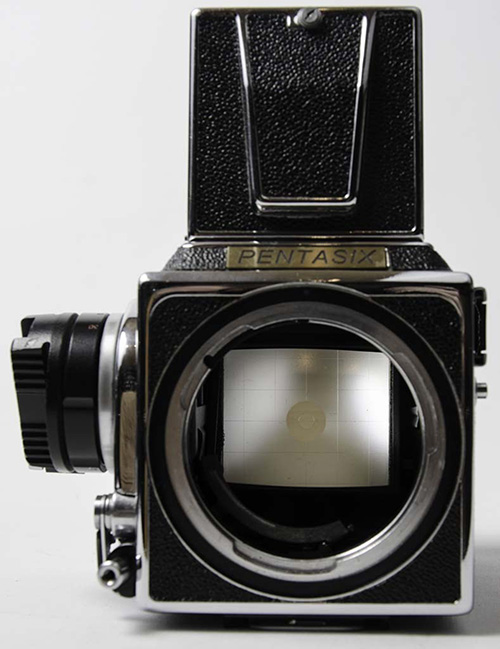 [wpx88_05.jpg] |
From the front view we can see
immediately that this Kiev 88 has had the lens mount
modified in order to take lenses with the Pentacon Six
lens mount. In fact, apart from the label, this
mount looks the same as the one on the "Kiev B.i.G" that I
bought from Brenner Fotoversand in Germany in the mid
1990s. See picture here. This is not as good as the lens mount that was subsequently developed for the Kiev 88 CM, which has a swing lever that emulates the action of the breech lock lens ring on the Pentacon Six. (See brief information on this here.) As the review of this mount on the Kiev B.i.G. makes clear, most Schneider-Kreuznach lenses for the Exakta 66 can't be mounted onto cameras with this version of a supposed "Pentacon Six mount". 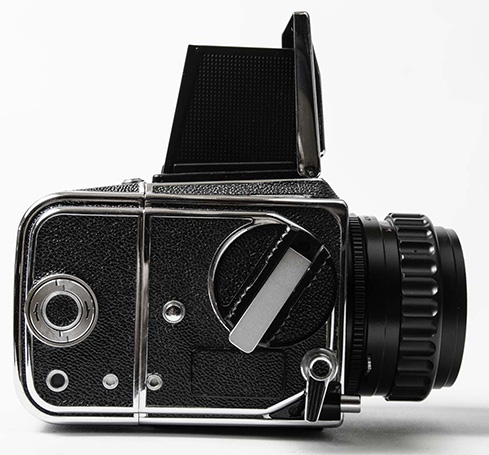 [wpx88_01.jpg] This side view of the same camera shows that it has a wind crank, which was not a feature of the original Kiev B.i.G. It also has an additional lever (bottom right in this image) which I believe may be a mirror pre-release. Perhaps more interesting is that its lens has the same style as the one that was supplied with the above "Kiev 60" Pentasix. |
| The book “Das Kiev Mittelformathandbuch”
states (p. 137) “Die
PENTASIX 636 von WIESE gleicht der von HARTBLEI
gelieferten KIEV 1006 M.”
“The
PENTASIX 636 from WIESE is equivalent to the KIEV
1006M that is delivered by HARTBLEI.” The
model “PENTASIX 636”
is the modified Kiev 88 shown here.
For more information on this book, see here and here. |
To choose other options, click below.
Home